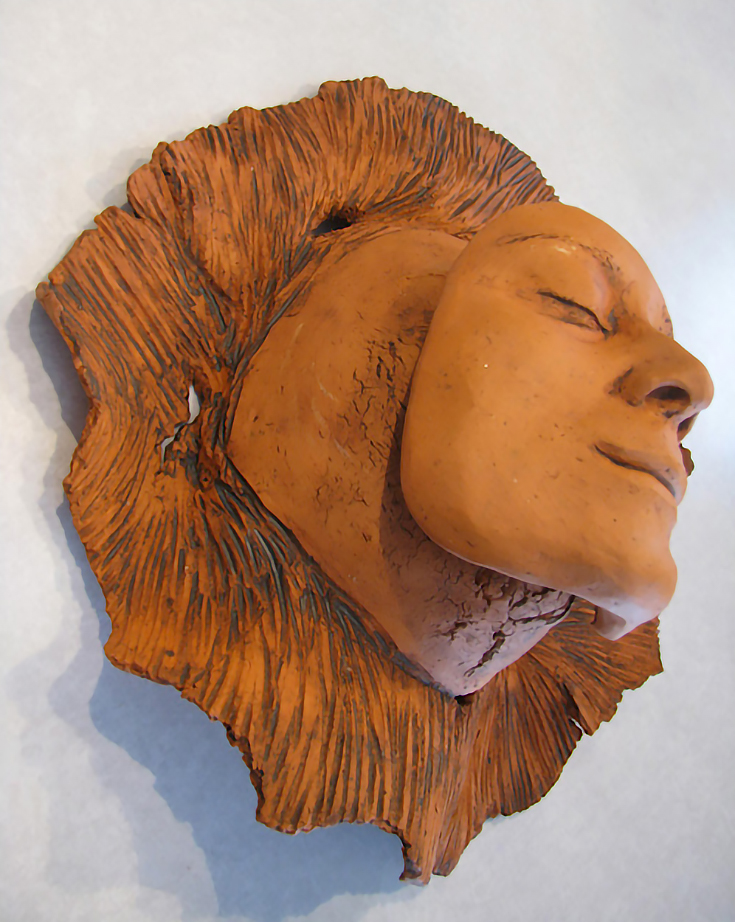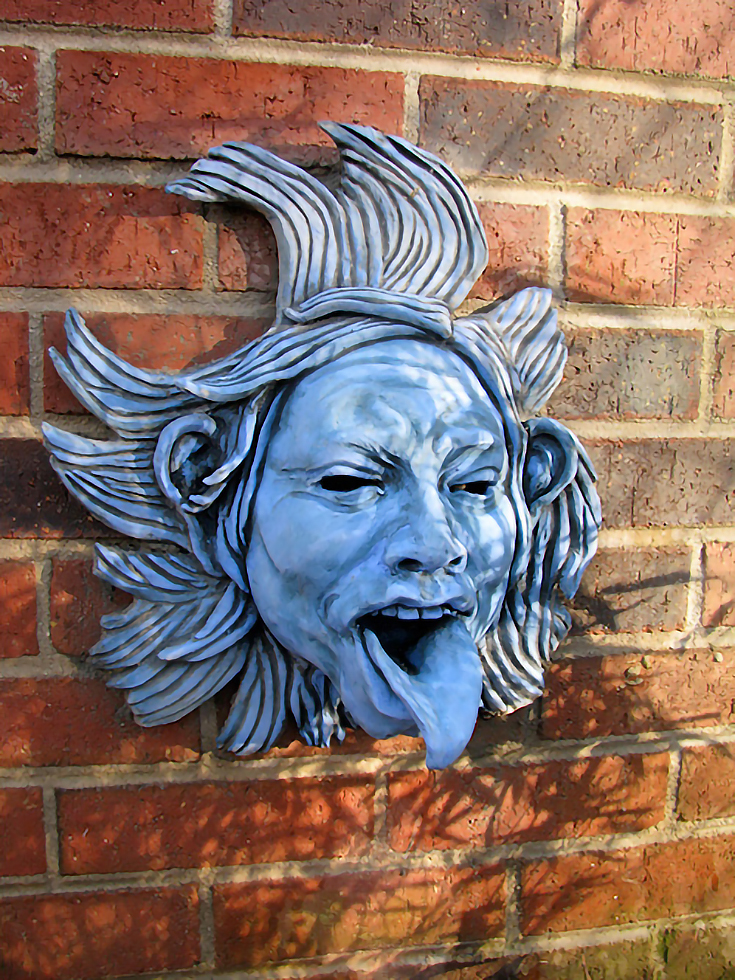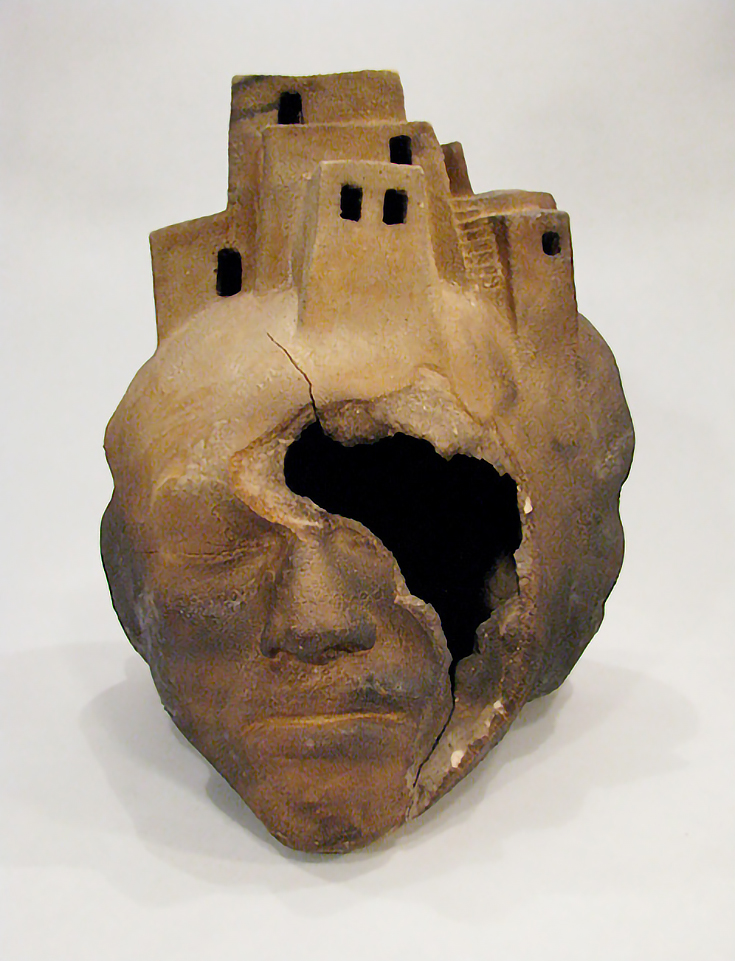
Anne Manner-McLarty has always been artistic, but her career as a consultant and business executive—which she pursued even while raising a family—often overshadowed her artistic life.
Now that her children are nearly grown, however, she has more time to devote to clay sculpting. . . a craft that continually challenges her to make artwork that is truly one-of-a-kind, and unique to her alone.
Join me as Anne shares some wonderful insight her creative process and why she believes art doesn’t have to be “all or nothing.”
Alyice: For those who have a hard time understanding the type of art you create, can you explain what clay art is?
Anne: I use all types of malleable material–natural clay, synthetic clays, even plaster and wax to sculpt. For years I made tiny, rather comical faces that were brightly painted. Of late, I’ve been working larger, using plaster molds made from my face and the faces of my family members as a starting place.
In order to expand the emotional range of the work, I took a class with Alex Irvine and improved my skill at expressing a specific emotion. My most recent ideas involve integrating other media with the clay (glass, paint, mosaic, natural stone and fibers) and a return to free-standing sculpture.
Alyice: What is your creative process like?
Anne: My life involves a lot of business travel, most often long car drives. I use that time to plan my sculptures. The outcome develops organically in my mind before I ever start and is as much an envisioning the process of making the piece as any specific forecast of the final product.
I decide which mold is closest to the mood I’m after for the piece. I decide which clay to use. I imagine myself making the casting from the mold and what work I’ll do to it from there.
During that time I am deciding whether the piece will be wall-mounted or freestanding and a lot about materials and tools I’ll use and the final coloration and character of the piece. Sometimes I even go as far as naming it and imagine myself explaining it to someone. However, I’m not married to the idea to the point that I don’t react to the clay as the process unfolds.
When the unexpected happens, I see it as something that was meant to be. The incremental decisions are what I find most rewarding. If an idea could be worked out completely in advance, the piece could be handed off for production. For me, that’s not art.
Alyice: How tricky is it to take an idea, like a sketch, and turn it into something three-dimensional?
Anne: I have a lot of experience sketching and my consulting career involves translating ideas into drawings that can be built by others. Because I think that way day in and day out, I’ve learned to solve and store a three-dimensional idea in my mind fairly well. I don’t sketch all my ideas, only the ones that I need to remember for more than a few weeks. Sometimes the ideas come along faster than I have time to address them and I don’t want to forget a good one.
Alyice: What is the most challenging part about working with clay?
Anne: I love pushing any material’s limits and clay is less forgiving than one might think. Although it is easy to add and subtract clay and you can change your mind mid-process or rework areas, there are technical decisions that must be taken into consideration from the start.
I’ve exploded several pieces firing them too quickly. I’m still learning to anticipate the shrinkage factor and the long-term implications of mixing media and putting clay-based work outdoors. But when things go wrong, I remind myself if an idea was worth doing, it’s worth doing twice!
Alyice: What is the best part about working with clay?
Anne: Working with clay that requires a kiln is fairly new to me. I am excited about making work that can be larger in scale and effectively permanent. Synthetic clays and plaster aren’t really well suited to outdoor applications. This new media has given me plenty of areas for experimentation and allowed me to think on a much larger scale. We’ve also expanded our studio to include two electric kilns and will soon be building an outdoor space for pit and raku firing.
Alyice: What do you wish you knew about clay before you got started?
Anne: I wish to be more familiar with the working of various kilns, clay bodies and glazes. I’ve tried learning this new information through books, and it just won’t sink in.
So far, the only way for me to integrate this information is through working with someone else or literal experimentation. There are a lot of variables, and things that “shouldn’t work” often do—to great success—while things that should be safe and stable sometimes go wrong. It’s not all science. There is a dance to working with the tools and materials.
Alyice: What do you believe is a key element in creating one-of-a-kind works?
Anne: Clay, as a medium, has confirmed that I am only interested in making one-of-a-kind sculptures. There are production ceramicists who spend years being able to control their technical ability to the point that they can make dozens of objects exactly the same size and shape. That doesn’t interest me at all.
Each piece is an exploration between my idea, my technical skill and the material itself. I encourage the unexpected and challenge the limits of my voice as an artist and each piece individually.
Alyice: How do you come up with a profitable pricing structure for your clay pieces?
Anne: If art is how you make your living, your sales plan must be structured in a documented plan that outlines sales goals, selling price, and market strategy. No artist can afford to price his or her work based on other artists’ sales prices.
Instead, unpleasant as it may seem, it is crucial that an artist look at his or her time as a commodity and multiply time spent by a factor that results in a livable wage. I’ve never been able to convert the time invested in making art into an income equivalent to what I can make in other markets. Therefore, I do not make art as a means of making my income.
My husband earned his living as an artist for many years–and does not now. I can remember that we were excited by every sale and hopeful that every media mention would be the “big break.” Things averaged out in a way that worked for our lifestyle, but there was a feast or famine aspect to his income.
Eventually, we decided to concentrate on consistent income in the years leading up to our kids’ entry into college. On the one hand, we don’t spend as much time making art, but on the other, we have more money to invest in new tools and supplies. We’ve found a balance that works for us that is not attached to reporting “artist” as our occupations on our tax forms.
Alyice: Do you do any promoting offline?
Anne: Recently, I was encouraged to begin showing again, not as a means of generating income, but as a way of garnering reactions and comparing responses by others to my own interpretations of the work.
I was surprised how easy it was to find venues for showing and promoting my work, both on and offline. So far, neither has generated sales, but that’s not been my goal. I think the fact that I am fairly prolific for one not producing art as a career has lent credibility to my portfolio. People are impressed by the volume and variety.
Alyice: What’s been your greatest success as an artist?
Anne: Marrying another artist, living a life that is filled with art and creative endeavors and inspiring others to include art in their day-to-day lives. I like being proof that art is not an all-or-nothing proposition.
Just because one doesn’t make a living from making art does not relegate the doing of it to “hobby.” I never list art as a hobby; it is as much a part of who I am as “mother” or “consultant” and ultimately more important than the career for which I am known.
Making something no one else has ever made or will ever make is what keeps me making art. That aspect puts me in touch with my unique nature, the reason I am here, more than anything else I do.
You can learn more about Anne and her art, via her Facebook page.
This post may contain affiliate links.



